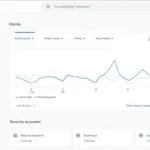Google Analytics 4 (GA4) offers a wide range of metrics to track website performance. While the most important metrics can vary depending on specific business goals, here are some key metrics in GA4 that are commonly used across various industries:

1. User Acquisition:
- New Users: The number of unique users who have visited your site for the first time.
- Sessions: The total number of times users have interacted with your site.
- User Acquisition Channels: The sources from which users are coming to your site (e.g., organic search, social media, paid advertising).
2. User Engagement:
- Average Session Duration: The average amount of time users spend on your site per session.
- Pages per Session: The average number of pages viewed per session.
- Bounce Rate: The percentage of users who leave your site after viewing only one page.
- Engagement Rate: The percentage of users who engage with your content in a meaningful way (e.g., clicking on links, watching videos).
3. User Behavior:
- Event Tracking: Track specific actions on your site, such as button clicks, form submissions, or video plays.
- Conversion Rate: The percentage of users who complete a desired action, such as making a purchase or signing up for a newsletter.
- Time on Page: The average amount of time users spend on a specific page.
4. Revenue:
- Revenue: The total amount of revenue generated through your website.
- Average Order Value: The average value of orders placed on your site.
- Conversion Rate: The percentage of users who make a purchase.
5. Custom Metrics:
- Create Custom Metrics: Define custom metrics key metrics in GA4 that are specific to your business goals and track them using GA4’s event-based tracking.
Remember to:
- Set Goals: Define specific goals for your website and track their progress using GA4.
- Segment Data: Use segments to analyze data for different user groups or time periods.
- Utilize Reports: Explore GA4’s pre-built reports and create custom reports to gain deeper insights.
By tracking these key metrics, you can gain valuable insights into your website’s performance and identify areas for improvement.


